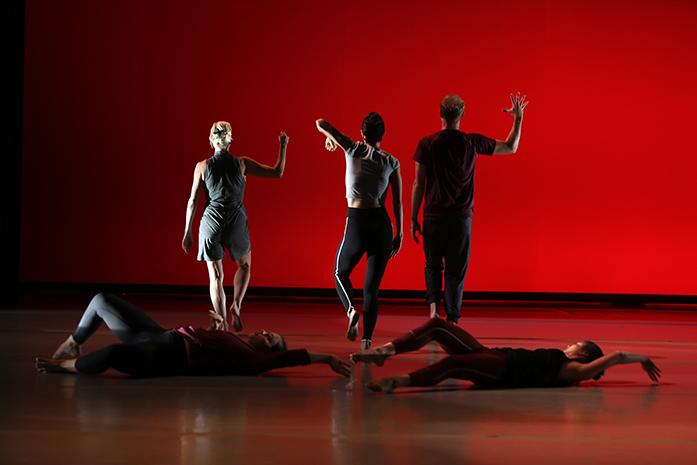By Claire Dietz
Professor Armando Duarte’s piece begins with a flourish. The lights go up. We see a group of dancers on stage enact with movement the physical manifestations of pain. They move across the stage slowly at points, their mouths agape in silent screams.
The University of Iowa Dance Gala will begin at 8 p.m. today in Space/Place. This year, the selection includes a wide variety of work, some addressing such topics as pain and caring, while another contains a ritual to the sun.
“DORNOOMBRO,” (shoulder pain), is Duarte’s piece, which reflects on how we inhabit our bodies.
“The piece is not a narrative of pain but a reflection on the sensations of pain,” he said. “They’re very colorful, movement-wise, but also in terms of the world I create with the dancers.”
The piece was largely choreographed and refined through collaboration with the dancers, and Duarte believes this was essential to its creation.
He found one of the most challenging aspects to be finding a way to express himself through something he found so limiting — pain.
“This piece isn’t a presentation of pain,” he said. “No one’s shouting ‘OUCH,’ but it’s more about the sensations and the experience I had transferred onto them. I had to expose myself and be humble, very humble, and engage them in this process.”
One piece, by this year’s artistic director, Associate Professor Charlotte Adams, is titled “She Drives Me Crazy” and explores the over-diagnosis of hysteria as a condition in the Victorian Era.
“I had been doing some research on female hysteria and how it was diagnosed during the Victorian Age,” she said. “I’ve approached it from a number of points of view, with a sense of humor that starts out the piece and pokes fun at the notion of a hysterical woman.”
One way Adams wanted to bring that onto stage was through hoop cages, which gave hoop skirts their shape. She found a striking parallel between the physical embodiment of being caged and the sensation of feeling caged.
Adams said the dancers had practiced their movements and routines in rehearsals without the cages, but once they arrived, the dancers’ movements became restricted as well.
Associate Professor Eloy Barragán, another choreographer, found his inspiration in Jaime Sabines’ poem “Los Amorosos.”
“It’s a beautiful poem about waiting, waiting for nothing,” he said. “They’re waiting for love. What is love? People believe they can find love easily, and Los Amorosos laugh at them because it’s difficult. It’s crying and waiting, because it is so difficult.”
Barragán also created roles in the piece for his dancers based on their own notions of love. The piece was molded around them, as opposed to being a strict idea in his mind.
Perhaps the most notable piece of the night is a restaging of Martha Graham’s “Acts of Light — Ritual to the Sun,” which is staged by grad student Jesse Factor.
Graham is best known for her Graham technique, a modern-dance style she created, tested, and perfected on herself.
Factor himself danced the piece while at the Martha Graham school and was excited to see how it had changed for him.
“I get to see it go from my teacher’s body to my body to my student’s bodies,” he said. “It’s a very powerful piece, and the dancers are really finding power within themselves.”
“Ritual to the Sun” is based on Graham’s own life growing up in the industrial city of Pittsburgh before moving to California. Once on the West Coast, Graham was enamored with the abundance of sunlight she found, as opposed to the dark and gloomy town she had left behind.
Now, years later when Factor teaches the piece and rehearses with his students, he is brought back to when he learned and danced the piece, what he describes as a “great and exciting time” in his life.
“I hope it’s as exciting for them as it is for me,” he said. “It’s such a joyful process to be involved with them, to answer their questions, to encourage them. Instead of feeling the structure of the material … They’ve taught me the fundamental power of the work through teaching it to them.”



